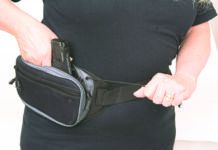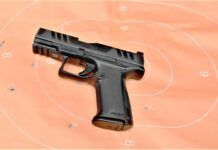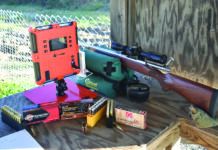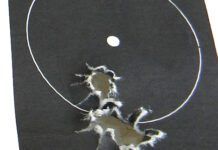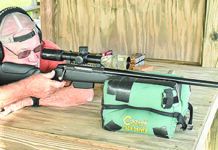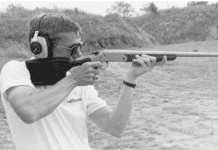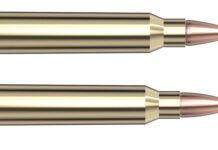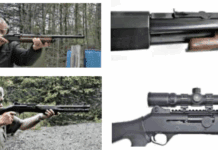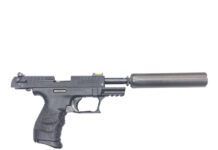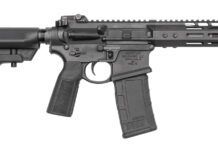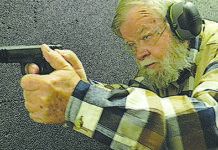Throughout American history, citizens have adopted the military arms of the nation for civilian use. Today, the military-based semi-auto AR-15 platform is showing the genius of Eugene Stoner by being adopted for a multitude of uses, in particular as a hunting round for medium-sized big game. One cartridge particularly suited to this role is Remington’s 6.8 SPC, an intermediate cartridge originally developed by the U.S. Army’s Marksmanship Unit and Special Forces personnel to provide more power and penetration than the standard 5.56 NATO round, while maintaining compatibility with the AR-15 platform. The 6.8 SPC round, topped with appropriate hunting bullets, is currently being used in the field to harvest deer, hogs, and other large game. Thus, our interest in testing two very different rifles chambered in this cartridge, the LWRCI M6A2 and the Battle Rifle Company M4 Odin.
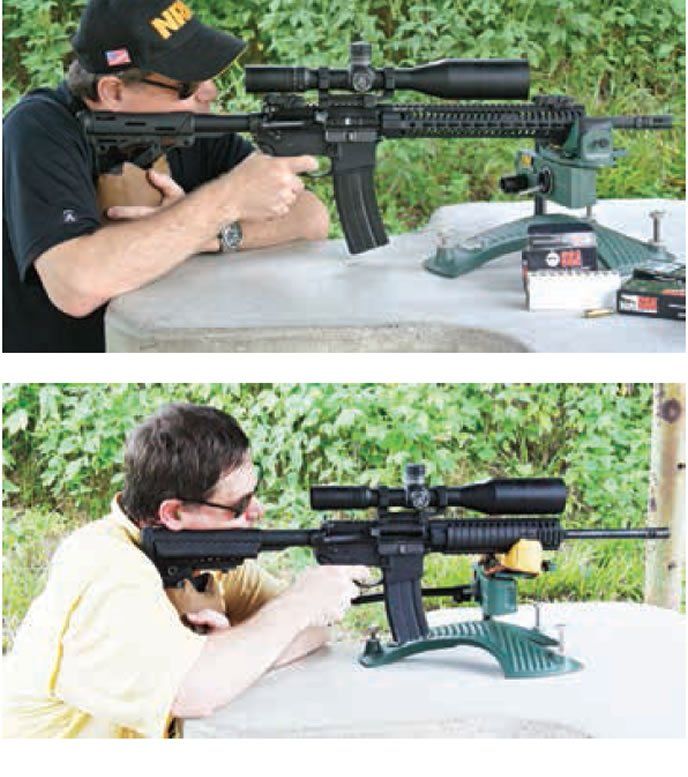
The 6.8 SPC is a cartridge that pushes the performance envelope for the AR-15 platform. Over time, there have been several specifications published for the chamber, with a great deal of discussion regarding the compatibility between the different specifications. However, the available data shows the differences between chamber specs are minimal, so compatibility should not be a problem. It’s worth noting, though, that one ammunition brand in this test, Silver State Armory, suffered two case ruptures. As there was one rupture in each rifle, and both failures were early in the testing cycle, we are inclined to think the issue was with the ammunition and not the rifles’ designs or cleanliness. Having two ruptures in one test does not inspire confidence in the ammunition, so we wanted to mention that immediately.
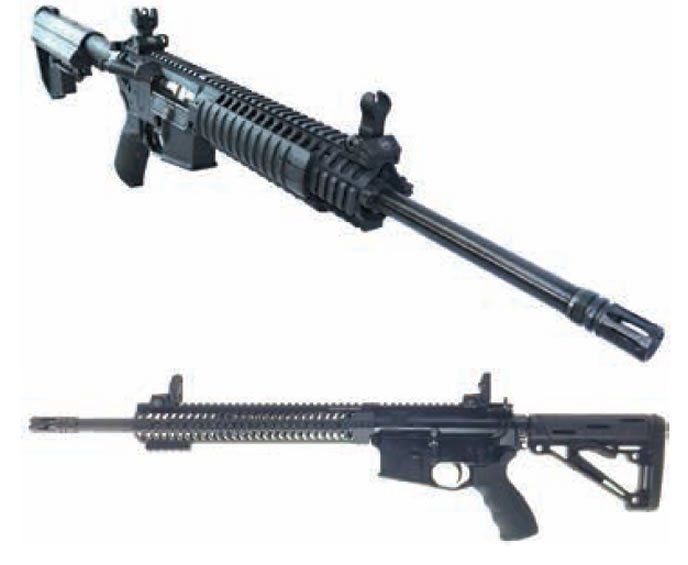
LWRCI is headquartered in Cambridge, Maryland. The company says its mission is to provide “durable tools for the warfighter and law enforcement officer.” According to the company’s website, LWRC International (LWRCI) “was founded to pursue the development of a short-stroke gas-piston-operated version of the AR-15/M16/M4 family of weapons.” The company says it focused on eliminating the inherent shortcomings in the direct-impingement operating system, resulting in the family of M6 rifles and carbines.
The LWRC International M6 series rifles are rotary-bolt, magazine-fed, air-cooled, self-loading designs chambered in 5.56x45mm NATO and 6.8x43mm SPC. Some of the more common variations include the M6SL, a lightweight mid-length unit with polymer handguards; the M6A1, which has an A-frame front sight and quad-rail handguards; the M6A3, which has a four-position gas block, a mid-length action, and a mid-length quad rail; and the M6-SPR, which has a low-profile gas block and SPR configurable rail system. Our test unit was the M6A2 version, which has a low-profile gas block with a mid-length quad rail and heavy-duty polymer rail covers. The M6A2 retains about an 80% parts commonality with the direct-impingement carbine.
Battle Rifle Company was started in April 2010 and is based in Houston. The receiver on our rifle was stamped Seabrook, Texas. The company sells direct to the consumer or through its dealer network. The BR4 Odin gets part of its name from the Odin Works 12.5-inch keymod rail, which keeps weight down while allowing many accessory configurations. The BR4 designation is what the manufacturer gives all its guns with a 16-inch or shorter barrels. The 14.5-inch barrel has a Battle Rifle flash suppressor mounted permanently. The gun comes with a soft zippered case and one 25-round magazine. This was a direct-gas-impingement action, so it allowed us to compare it head to head with the piston gun for cleanliness, coolness, and function.
How We Tested the SPCs
To collect accuracy data, we fired five 5-shot groups from a 100-yard concrete bench at a private range in Houston. The rifles were supported by a Caldwell Fire Control Front Shooting Rest (MidwayUSA, $270, #956104) and sand bags. We used a Nightforce 5-25x56mm ATACR Riflescope with MOAR Reticle & Adjustable Parallax on both rifles. Each time, we shot confirmation groups before beginning an accuracy string. We cleaned the rifle bore between ammunition types. We aimed at Redhead 12-inch Sight-In Targets #135-997, which have 6-inch black center diamonds and four 3-inch-diameter black diamonds. They are available from BassPro.com. We tested with the following three varieties of ammunition: Hornady 110-grain V-Max and Silver State Armory’s 115-grain OTM and 85-grain Frangible. Here’s more of what we learned about these rifles:
LWRCI M6A2 Gas Piston Carbine M6A2R6B16 6.8 SPC, $2250
The price above was the out-of-stock price at Impact Guns. Rockwell Arms had the rifle for $2240 and noted that it ships in 12 to 24 months. On Armslist.com, we found a handful of private sales offering this rifle for $1400 to $1600, some for an unfired NIB model, which doesn’t account for FFL and shipping charges to the buyer, of course. The LWRC International M6A2U6B16 ships standard with a box and one 30-round magazine. Our private-sale gun, $1499 came with three mags, however. The website lists the available colors as black, flat dark earth, olive-drab green, and patriot brown.
LWRCI says its patented self-regulating short-stroke gas-piston system eliminates the venting of hot, carbon-laden gases into the receiver and bolt carrier group, thus eliminating the intensive cleaning regime of the “legacy” rifle. We found the LWRCI M6 easily field stripped and cleaned like any other piston AR. As is common with piston-driven rifles, the bolt showed little carbon fouling. A normal amount of carbon and copper fouling was in the bore.
Another supposed benefit of the company’s short-stroke gas-piston system is improved handling characteristics, lighter recoil, and reduced muzzle rise. On our first testing day, our team started shooting the SSA 115 OTM with no failures, and our team commented on the rifle’s even pulse and mild recoil. It was slightly more than a 5.56 round, we thought. We had no failures with the SSA 85-grain frangible and noted the same even pulse and mild recoil, which we thought was no more than a 5.56 round. The Hornady 110-grain V-Max likewise had no failures and felt the same as the SSA 115s. The brass fell in a 6-foot circle behind and to the right of the shooter. This short ejection distance may be important to handloaders.
We don’t agree with the company’s claim of improved handling. What we found with the M6A2 was a well equipped unit with an extensive rail system, rail covers, back up iron sights (BUIS) and a heavy-duty collapsible stock. All this equipment came at a price, as the rifle felt heavy enough that the testers would be less than enthusiastic about carrying it all day. Despite the weight, the rifle was well balanced and shot well from a variety of field positions, but we’re not sure that qualifies as “improved.”
The company talks a lot about its barrels. Because the tubes are dense and thick, “these barrels can take a lot more use and abuse than a standard barrel before any degradation in accuracy or loss of velocity.” LWRCI says, “Our barrels can handle 20,000 rounds before replacement, as compared to 6,000-10,000 rounds on a standard M4.” This is of obvious value on a “sandbox” rifle, but the domestic consumer may not want to pay the freight and tote the weight that results.
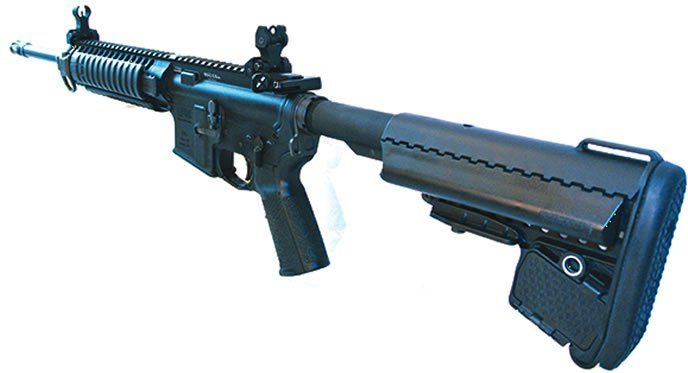
The rifle gave off a general sense of quality. The fit was tight and the finish showed consistent coloration. The controls were smooth and positive. The rifle was provided with three magazines manufactured by Barrett, which were clearly marked on the outside with the caliber. They locked and ejected easily. The bolt and bolt carrier were particularly nice, with a smooth and hard proprietary nickel coating that provides permanent lubrication to the moving parts. It was very easy to clean. The single-stage Mil-Spec trigger at 7.5 pounds was nothing special, but the Mil-Spec rating in this case means “not great.” It had a fair amount of creep, but it broke consistently within plus-or-minus 4 ounces of the average, and the reset was positive and short.
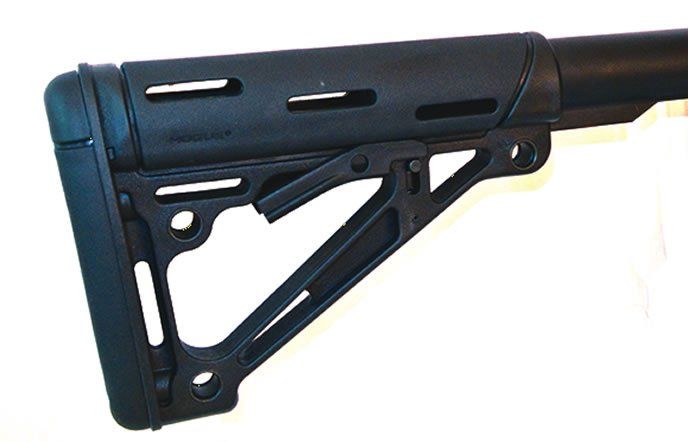
The LWRCI showed a preference for the Silver State Armory ammunition, shooting the 85-grain frangible lead-free bullets into 1.4-inch average groups and the 115-grain OMT into 1.6-inch average groups. The Hornady ammo lagged at 2.0 inches. The rifle proved completely reliable with boxed ammunition. The only failure encountered was during our initial familiarization drills — a ruptured case from a batch of bulk new ammo.
The Magpul MIAD grip was com-fortable to grasp, and its adjustable backstraps made individual fitting possible. Up top, any Mil Std 1913 accessory can be mounted to the rail, and because the rail is monolithic, the shooter can bridge devices from the receiver to the rail.
Our Team Said: This is a well-built, reasonably accurate 6.8 SPC-chambered rifle. We gave it our top grade, but we need to be honest and say none of our testers wanted to buy it after the test.
Battle Rifle Company BR4 Odin 6.8 SPC, $1495
There were several variations between how the company specs the gun and what we tested. The website said the Odin comes standard with a Magpul stock; our was a Hogue OverMolded collapsible buttstock. This reinforced-polymer item had a rubber cheek rest and a rubber/polymer hybrid butt pad that provided snag-free rifle shouldering. It also had a snug anti-rattle friction fit that we liked. Company specs said the Odin comes with a Magpul B.A.D. lever, which our gun lacked. Company specs said the trigger was polished and adjusted to a 4- to 6-pound break, but ours let off at a heavy 8.5 pounds. It did have a single-point sling adapter on the buffer tube and an extended trigger guard (Magpul).
The Battle Rifle Company M4 was simply fitted and remarkably light. The testers really liked the design of the narrow Odin hand guard. It was lightweight and allowed good air circulation to help prevent heat buildup. The hand guard will allow the attachment of small rail sections in case the user feels the need to add accessories.
The fit was good and the finish was consistent. Balance was good with a very slight forward weighting. The rifle also came to the shoulder securely and consistently.
Overall the testers found this rifle easier to use from field positions than the LWRCI, a definite plus for a true hunting rifle. However, the trigger was very stiff and made accurate shooting much more difficult than it should have been. Also, due to its lighter weight, the rifle had more recoil than the LWRCI. Most of the testers found the recoil was still quite reasonable, although the teenage girl in the group found the LWRCI more comfortable to shoot.
The BRC also shared a preference for the Silver State Armory ammu-nition, consistently grouping within a few tenths of an inch of the LWRCI M6A2. The BRC shot the 85-grain frangible lead-free bullets into 1.8-inch average groups and the 115-grain OMT into 1.5-inch average groups, slightly better than the other gun. The Hornady ammo shot the same in the BRC — 2.0 inches — as it did in the LWRCI.
Our testers said the rifle seemed to group better with a very firm hold against the shoulder. The rifle ran coolly, probably due to the excellent hand guard design. All three rounds also showed greater velocity in the BRC than the LWRCI M6. However, that is where the good news stopped.
All three ammunition brands exhibited multiple types of failure in the BR4. We had failures to strip the first round with several magazines, failures to feed, failures to extract, and double feeds. We even had another ruptured case, this time with the factory SSA 115-grain ammunition. Specifically, in our first session, the SSA 115 OTM and Hornady 110 V-Max suffered no failures. But the SSA 85-grain had four failures to feed. In our second session, the 85 Frangible had five failures to feed with the bulk ammo and one FTE, so we re-lubricated the rifle. This proved ineffective, as we had an additional 15 failures of various types.
At this point, we field-stripped it for cleaning using the usual AR-15 procedures and saw that it was extraordinarily dirty. After cleaning, we function-tested the rifle again. The rifle digested 120 rounds of four different types of ammunition mixed at random in less than 10 minutes with no problem whatsoever.
We can only conclude that this particular rifle required a break in period, during which it was very sensitive to cleanliness.
Our Team Said: Based on its initial function problems, a heavy trigger, and middling accuracy, we think there are better choices out there than the Battle Rifle Company BR4 Odin. To its credit, however, the rifle is affordable and has some great features, such as the Odin handguard.
Written and photographed by David Tannahill, using evaluations from Gun Tests team testers.


